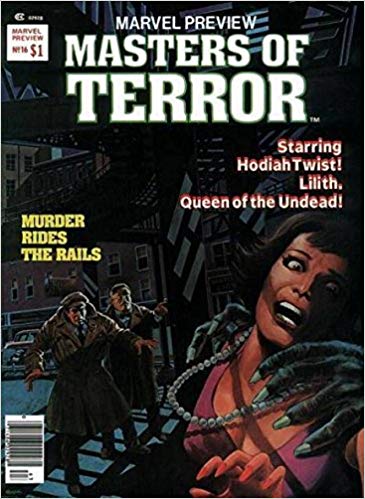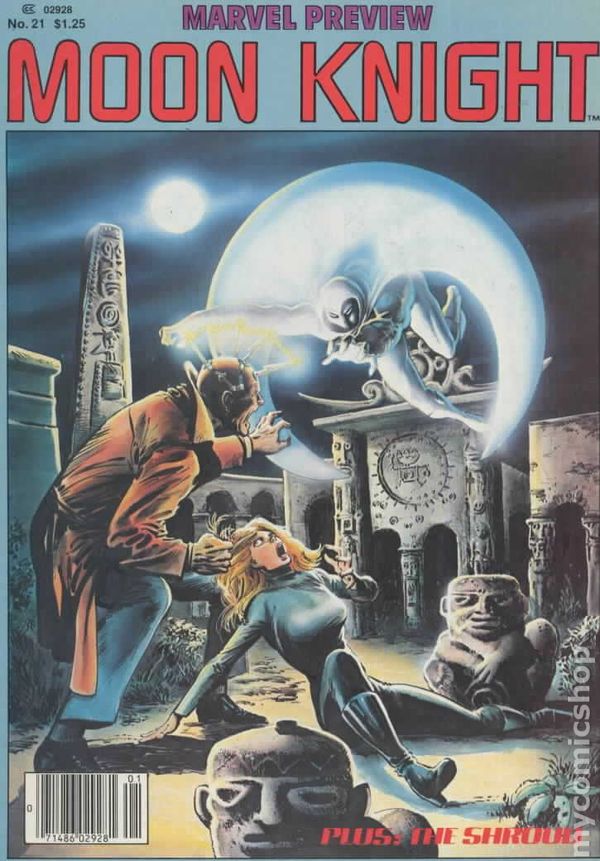Comic Book Review: Marvel Preview #16 & 21 by various creators
Marvel Preview was a black & white comic book magazine distributed through newsstands starting in 1975 for 24 issues before being retitled Bizarre Adventures for another ten issues. It was an “umbrella title” like DC’s Showcase, with a different theme or major character in each issue. Because magazines weren’t subject to the Comics Code, the subject matter tended to be grittier than the mainstream Marvel comics. I recently came across two issues.

#16: “Masters of Terror”, is a horror issue, tied together by the art of Gene Colan, whose stuff looks excellent in monochrome.
“The Hero-Killer Principle!” written by Richard Marschall, stars Hodiah Twist, formerly a successful businessman until the stock market crash of 1929 and the loss of his family caused him to crack. He now fancies himself a Sherlock Holmes-style private investigator, complete with Watson-like companion Conrad Jeavons.
They’re trying to track down a serial killer who preys on passengers of the elevated trains in the 1930s. Having successfully predicted the killer’s pattern, Hodiah must discern which of a rapidly shrinking pool of suspects trapped in a railway car is the murderer. An amusing twist is that one of the suspects, Mildred Argot, also fancies herself a detective, but more in the Miss Marple “snoopy old lady” vein. But that doesn’t make her less of a suspect!
“Voices” written by Marv Whitman is a short shocker about a man who’s discovered that his CB radio can broadcast to his neighbor’s TV set. His neighbor is mentally handicapped, and believes the broadcasts are the voice of God. The CB-owning man turns out to be a cruel god, who instructs his worshiper to murder people. The police are baffled by the seemingly random “Magnum Murderer.” But then the CB owner overreaches, and the scheme collapses. Prejudice and verbal abuse towards people with mental disabilities is on display.
“The Rise of the Private Eye” by Ron Goulart is a text feature about how tough-guy private detectives became the big thing starting in the 1920s and developing through the movies of the 1930s.
“Death by Disco” written by Ron Goulart, stars Lilith, Daughter of Dracula. She’s one of those characters with a convoluted backstory. Briefly, she was Dracula’s daughter by his first wife, cast out when he married the woman he actually loved. When Dracula then attacked the people she was staying with, one of them magically cursed Lilith with vampirism so that she would eternally oppose her father.
Whenever Lilith is “killed”, her essence is transported into another young woman who hates her father. At this point Lilith is in the body of Angel O’Hara, a pregnant woman whose father had killed her husband. Angel currently lives with Martin Gold, a writer who’s having a “writer’s block” problem and refuses to take lesser work while he is stuck on his masterpiece.
So Angel decides to take a little freelance journalism assignment by reporting on the then-fashionable disco scene. This turns sour when a “nice guy” hits on Angel and is turned down, then is goaded into assault by his “buddy.” Angel instantly is replaced by Lilith, who slaps down the offender.
The rather stunning and flashily dressed Lilith then attracts the attention of T.J. Novello, the local “disco king”. While he’s a sleazebag, T.J. is also an excellent dancer. His life-loving attitude attracts Lilith. But the “buddy” mentioned earlier pours poisoned words into the ear of T.J.’s regular dance partner, and tragedy ensues.
If you like Gene Colan’s art, this is a good collector’s piece.

This issue’s theme is “superheroes in monochromatic outfits with hooded capes”.
The lead feature, in all white, is Moon Knight. He’d first appeared as an antagonist in Werewolf By Night fighting the mostly-heroic lycanthrope Jack Russell. His origin seen there (mercenary given costume and weapons by a criminal syndicate) got retconned and Moon Knight became a more heroic figure. He was now former mercenary Marc Spector, who’d had a “religious experience” in the hidden temple of the Egyptian moon god Khonshu.
Armed with treasure from the temple, Spector created two alternate identities with distinctive mannerisms, wealthy investor Steven Grant and tough taxi driver Jake Lockley, each of whom gave him access to different social classes. Along with his costumed Moon Knight persona, they represented different sides of Spector, like the phases of the moon. (Later on they would become full-fledged alternate personalities.)
“The Mind Thieves” written by Doug Moench, pencils by Bill Sienkiewicz, begins with Spector being shipped the corpse of an old friend from his CIA days. Moon Knight investigates with help from helicopter pilot Frenchie, and his lover Marlene Alraune. Turns out some CIA mind control experiments have borne fruit with a remote-controlled assassin!
The black and white magazine titles didn’t have to follow the Comics Code (but still had to be newsstand acceptable) so we get some tasteful nudity. This is early Sienkiewicz in his Neal Adams homage phase, before he developed his unique style. The story itself is okay.
Contrasting is the Shroud, in all black. A Batman homage, Maximillian Coleridge’s parents were murdered when he was a child, and he dedicated his life to fighting crime. After getting a criminology degree, Max joined the Cult of Kali to learn martial arts. (You’d think the name would have tipped him off.) After seven years of intense training, the cult blinded him with a branding iron in a ritual that gave him extra-sensory perception. He then adopted the identity of the Shroud.
The Shroud first appeared in Super-Villain Team-Up, battling Doctor Doom and the Red Skull. The results of this left the Shroud able to summon darkness around him (which took a while to figure out given he can’t see.)
“Walk a Crooked Mile” written by Mark Gruenwald and Steven Grant (who would later become Moon Knight’s writer) and art by Steve Ditko, starts a new phase in the Shroud’s career. Much like the Green Hornet, the Shroud poses as a criminal to infiltrate and destroy West Coast organized gangs.
In this story, that’s the gang run by the Crooked Man, a Two-Face-style character who looks like two different people badly pasted together. He considers himself an art connoisseur, and kidnaps a modern hot artist partly for the ransom, and partly because he hates the painter’s work. With his new ally the Shroud, the Crooked Man will be unstoppable! Well, except for the part where he plans to betray the Shroud from the beginning. Crooked Man goes to jail, the artist goes free, and the Shroud gains the allegiance of Cat, a skilled burglar, and Mouse, a pickpocket.
The story plays to the strengths of Ditko’s visual style, and the Crooked Man is a pretty good one-shot villain. This is one of the very few Shroud solo stories, as he’s always been much more of a guest star character, and has never had his own series.
Some of the Marvel Preview/Bizarre Adventures stories have been anthologized elsewhere, but many have not, so it may be worth your while to spot them at garage sales and other odd locations.

